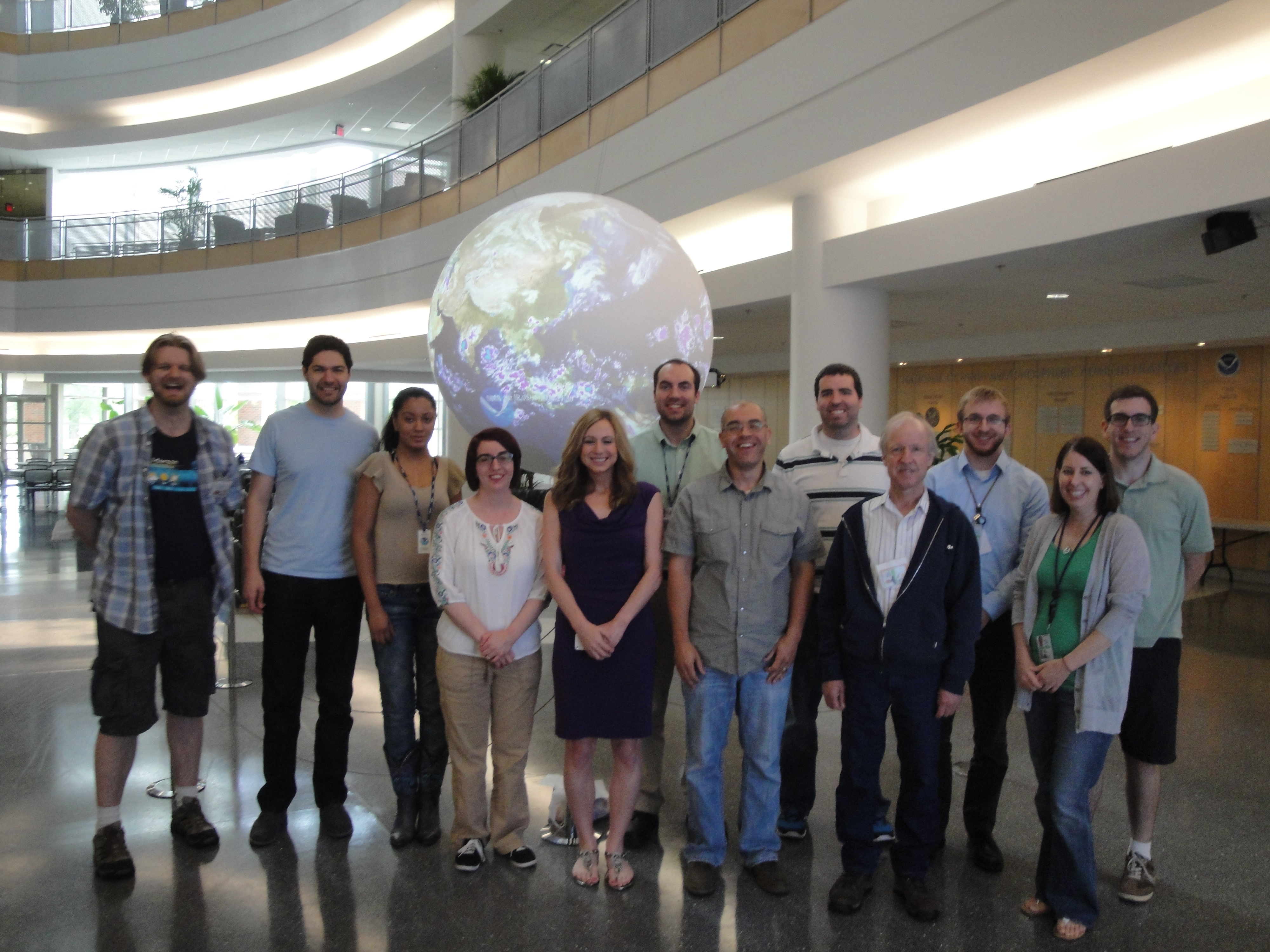Project Overview:
This was first week of our four-week spring experiment of the 2014 NSSL-NWS Experimental Warning Program (EWP2014) in the NOAA Hazardous Weather Testbed at the National Weather Center in Norman, OK. “The Big Experiment” or “Spring Experiment” had three components: (1) an evaluation of multiple CONUS GOES-R convective applications, including satellite and lightning; (2) an evaluation of the model performance and forecast utility of two convection-allowing models (the variational Local Analysis Prediction System and the Norman WRF); (3) and an evaluation of a new feature tracking tool from NASA SPORT. Additionally we coordinated daily with Experimental Forecast Program, participating in briefings and evaluating the probabilistic severe weather outlooks produced by their forecasters as guidance for our warning operations.
Participants:
Our NWS participants were Joshua Boustead (WFO Omaha, NE), Linda Gilbert (WFO Louisville, KY), Grant Hicks (WFO Glasgow, MT). Our visiting broadcast meteorologist for the week was Danielle Vollmar of WCVB-TV (Boston, MA). The GOES-R program office, the NOAA Global Systems Divisions (GSD), and the National Severe Storms Laboratory provided travel stipends for our participants from NWS forecast offices and television stations nationwide.
Visiting scientists this week included Steve Albers (GSD), John Cintineo (Univ. of Wisconsin/CIMSS), Ashley Griffin (Univ. of Maryland), Chris Jewett (Univ. of Alabama – Huntsville), James McCormick (Air Force Weather Agency), Chris Schultz (Univ. of Alabama – Huntsville), and Bret Williams (Univ. of Alabama – Huntsville).
Darrel Kingfield was the weekly coordinator. Lance VandenBoogart (WDTB) was our “Tales from the Testbed” Webinar facilitator for his last week (we’ll miss you!). Our support team included Kristin Calhoun, Gabe Garfield, Bill Line, Chris Karstens, Greg Stumpf, Karen Cooper, Vicki Farmer, Lans Rothfusz, Travis Smith, Aaron Anderson, and David Andra.

Feedback on Experimental Products:
-
The technique is great, to be able to visualize what the satellite would look like if this model were to pan out.
- Sometimes it got the correct position and missed the timing, sometimes it got the timing and missed the position.
- Would be great to integrate with other model solutions.
-
I liked that you could see the areas of higher instability. When I used it in conjunction with the ProbSevere or CI products, I found it helpful to see if cumulus field is developing in a region of higher instability.
- The wide spectrum of colors allowed for the analysis/tracking of instability gradients
- Lots of blank spots due to cloud cover, becomes hard to use in heavily overcast conditions. Would be great to blend with other NWP solutions.
- I could see myself going to this product between warnings see where the Theta-E gradient is located.
- Could be used to fill the spatial gap between sounding data sites.
- Really helped focus my attention to specific regions of favorable convection and block out other regions for now.
- Could catch a forecast off guard if he/she is unaware of the deficiencies (e.g. poor detection capability under cirrus).
- Mixed results depending on isolated initiation versus new initiation in a complex convective setup.
- I’m unsure how well GOES West is performing compared to GOES East.
- I liked the verbal annotations next to the metadata (e.g. Moderate, Strong)
- After initial hesitation, the algorithm performed really well today (5/20) and I was confident in using it as guidance.
- Highlighted storm collapse, helping me not issue warnings on storms that were weakening.
- I could see this catching things a human would miss but we should still use it in conjunction with base data.
- The 15-30 minute updates made it difficult to use, I’d be more receptive to 1 minute updates.
- I see more overshooting tops than what the algorithm is detecting but see its potential when there is no visible imagery (i.e. nighttime).
- I could see this filling the gap in a data void region without radar.
- 1 minute data allowed me to gain more confidence in what I was seeing. I saw convective attempts, failures, and dead anvils…something I could not see as clear without SRSOR imagery.
- The detail seen in convective development was phenomenal, I could stare at this all day.
- I was able to visually identify boundaries feeding into the storm faster than what radar could provide to me.
- CG information did not tell the whole picture, it was great to see the ups and downs in electrification.
- I could definitely integrate this into warning operations.
- Definitely helps in monitoring the health of the updraft pulse.
- I factored the sigma jumps into my decision making process and overall it performed well.
- I think it has potential but the bugs/freezing when loading a lot of data made it difficult to use.
- I tracked base velocity with this tool and when multiple meteograms started popping up, I just closed it out.
- I liked how the path prior trajectory changed by moving a single circle but it will take some time for me to do this faster. Unsure how to integrate this into fast-paced convective modes.
- Seemed to overproduce convection consistently but I found the instability parameters useful.
- Wind and Theta-E fields would be an added benefit.
- Odd features seemed to propagate near the edges of the domain, which sometimes made the small domain products difficult to use.
- Composite reflectivity seemed way to hot to use this week.
-Darrel Kingfield, EWP Week 3 Coordinator
